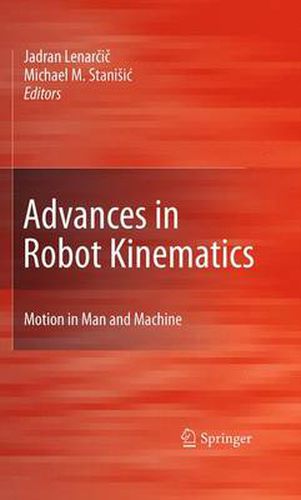Readings Newsletter
Become a Readings Member to make your shopping experience even easier.
Sign in or sign up for free!
You’re not far away from qualifying for FREE standard shipping within Australia
You’ve qualified for FREE standard shipping within Australia
The cart is loading…






This title is printed to order. This book may have been self-published. If so, we cannot guarantee the quality of the content. In the main most books will have gone through the editing process however some may not. We therefore suggest that you be aware of this before ordering this book. If in doubt check either the author or publisher’s details as we are unable to accept any returns unless they are faulty. Please contact us if you have any questions.
The ?rst International Meeting of Advances in Robot Kinematics, ARK, occurred in September 1988, by invitation to Ljubljana, Slovenia, of a group of 20 int- nationally recognized researchers, representing six different countries from three continents. There were 22 lectures and approximately 150 attendees. This success of bringing together excellent research and the international community, led to the formation of a Scienti?c Committee and the decision to repeat the event biannually. The meeting was made open to all individuals with a critical peer review process of submitted papers. The meetings have since been continuously supported by the Jozef ? Stefan Institute and since 1992 have come under patronage of the Inter- tionalFederationforthePromotionofMechanismandMachineScience(IFToMM). Springer published the ?rst book of the series in 1991 and since 1994 Kluwer and Springer have published a book of the presented papers every two years. The papers in this book present the latest topics and methods in the kinem- ics, control and design of robotic manipulators. They consider the full range of - botic systems, including serial, parallel and cable driven manipulators, both planar and spatial. The systems range from being less than fully mobile to kinematically redundant to overconstrained. The meeting included recent advances in emerging areas such as the design and control of humanoids and humanoid subsystems, the analysis, modeling and simulation of human body motion, the mobility analysis of protein molecules and the development of systems which integrate man and - chine.
$9.00 standard shipping within Australia
FREE standard shipping within Australia for orders over $100.00
Express & International shipping calculated at checkout
This title is printed to order. This book may have been self-published. If so, we cannot guarantee the quality of the content. In the main most books will have gone through the editing process however some may not. We therefore suggest that you be aware of this before ordering this book. If in doubt check either the author or publisher’s details as we are unable to accept any returns unless they are faulty. Please contact us if you have any questions.
The ?rst International Meeting of Advances in Robot Kinematics, ARK, occurred in September 1988, by invitation to Ljubljana, Slovenia, of a group of 20 int- nationally recognized researchers, representing six different countries from three continents. There were 22 lectures and approximately 150 attendees. This success of bringing together excellent research and the international community, led to the formation of a Scienti?c Committee and the decision to repeat the event biannually. The meeting was made open to all individuals with a critical peer review process of submitted papers. The meetings have since been continuously supported by the Jozef ? Stefan Institute and since 1992 have come under patronage of the Inter- tionalFederationforthePromotionofMechanismandMachineScience(IFToMM). Springer published the ?rst book of the series in 1991 and since 1994 Kluwer and Springer have published a book of the presented papers every two years. The papers in this book present the latest topics and methods in the kinem- ics, control and design of robotic manipulators. They consider the full range of - botic systems, including serial, parallel and cable driven manipulators, both planar and spatial. The systems range from being less than fully mobile to kinematically redundant to overconstrained. The meeting included recent advances in emerging areas such as the design and control of humanoids and humanoid subsystems, the analysis, modeling and simulation of human body motion, the mobility analysis of protein molecules and the development of systems which integrate man and - chine.